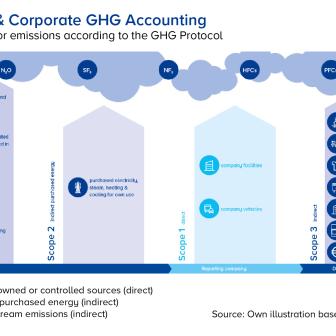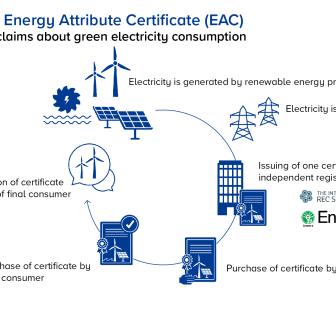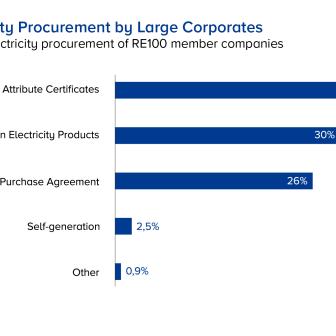How switching to renewable energy will reduce your company’s carbon footprint
July 9, 2021An Introduction To Green Energy
A Climate Action Insights on Green Energy by Samantha Bigwood-Ölz, Team Lead Green Energy, and Nina Piel, Green Energy Communications, ClimatePartner
Almost all economic activities have one thing in common: they require energy. It should come as no surprise, then, that approximately 73 % of global greenhouse gas (GHG) emissions in 2020 – or 31,500 million tonnes of CO2 – are attributable to energy-based activities. To this day, fossil fuels such as coal and natural gas remain the primary source of energy worldwide, although renewables’ contribution is rapidly increasing. To limit global warming to below 1.5 degrees above pre-industrial levels, the world's energy system must undergo a rapid transformation, and green energy is a major lever on the road to net zero.
But what exactly is green energy? And how can you buy renewable electricity for your company?
Why green energy is an important vehicle for your company’s climate action strategy
Let’s dive right in: green energy refers to electricity generated from emission-free natural resources such as solar power, wind power, or hydropower. They are also called renewable resources because they naturally replenish in contrast to fossil fuels. Biomass and geothermal energy are also renewable resources, even though they have to be closely monitored during the production process since biomass releases emissions (but far less than fossil fuels) during combustion. The largest renewable energy producers are China, USA, Brazil, India, and Germany.
Now, how will green energy consumption reduce your carbon footprint? Let’s have a look at the emissions side. The Greenhouse Gas Protocol establishes three categories for GHG emissions:
- Scope 1 covers all direct emissions in your own facilities.
- Scope 2 covers indirect emissions from purchased energy.
- Scope 3 covers indirect upstream and downstream emissions, such as from your company’s value chain and product use phase.
This is important to consider, especially when your company strives for carbon neutrality where it has to follow a three-step process: measure your carbon footprint based on these scopes, reduce your emissions everywhere you can, and offset all unabated emissions with certified high quality carbon offset projects.
By switching to zero-emission green energy you can avoid Scope 2 emissions, and this will greatly reduce your carbon footprint prior to compensation. That’s why green energy is such an important vehicle for your company’s climate action strategy.
But that’s not all: by sourcing green power, you can drive the global energy transition and position yourself as a sustainable leader, and role model for your industry. As did the global sports label PUMA: with support from ClimatePartner, PUMA switched to 100% renewable electricity for its worldwide operations in Europe, the USA, Canada, Latin America, Asia and Australia in 2020 – thereby also reducing their Scope 2 market-based emissions to zero!
(Illustration 1: Green energy & corporate GHG accounting)
What is an Energy Attribute Certificate?
When a company wants to procure green energy, this is done via Energy Attribute Certificates. All generated energy, whether renewable or fossil fuel based, is being fed into one common grid. This makes it quite hard to claim green energy: it is simply not possible to physically trace renewable electricity from producer to consumer. What comes out of your power socket is the average electricity mix.
This is where Energy Attribute Certificates come in: the so-called EACs have been established in a book and claim system to track the attributes of a given megawatt-hour (MWh) of electricity from a producer to a consumer. EACs are like an “ID badge” for electricity; they also exist for nuclear- and fossil-based electricity. In the case of renewable EACs, they provide proof of the unique attributes of each MWh of produced renewable electricity, such as:
- time and date of production
- location of the generation device
- generation technology (e.g., wind, solar, hydro, biomass, geothermal)
- age of the production device
What’s important to understand is that EACs are not about allocating the physical electricity flows but rather about allocating its attributes; the physical product and its environmental characteristics represent two separate markets. And, since there is no way to filter out the share of renewable energy from the common electricity grid, all procurement options for green energy are based on EACs.
Thus, to credibly claim green energy consumption, you must match the volume of your electricity consumption in a given year with the corresponding number of Energy Attribute Certificates. Once your EACs have been matched, they will be cancelled in your name to ensure that each certificate is only being used once, i.e. to avoid double claiming.
If you already have a green energy tariff at home, this might come as a surprise to you as you’ve probably never heard of these certificates, right? With green tariffs, the actual electricity and the associated EACs both run through the electricity provider. In this case, your energy supplier cancelled the certificates on your behalf and supplied you with energy from the average grid mix without you ever seeing these certificates. That’s one way of procuring green energy. We’ll move on to the different options later on.
The international Science Based Targets initiative (SBTi) which enables companies to set science-based emissions reduction targets supports this approach. Other international sustainability related standards that aim to drive emissions reductions such as the global disclosure system to manage environmental impact CDP and the global corporate renewable energy initiative RE100 with over 300 committed companies have given their approval to EACs as well.
(Illustration 2: Lifecycle of an Energy Attribute Certificate)
Are EACs a form of greenwashing?
No. There is often some uncertainty about whether EACs are a form of greenwashing – some even fear it’s a form of indulgence trade because the power coming out of your wall socket is still the average grid mix. Yet, if you are neither self-generating electricity nor have a direct line to a renewable energy installation, you cannot influence the physical electricity you’re receiving. That’s why Energy Attribute Certificates are so crucial: only those companies obtaining and cancelling EACs can credibly claim renewable energy consumption.
How to find a suitable Green Energy procurement option
All procurement options for green energy are based on EACs. However, there are different options for you to choose from depending on availability, cost, complexity and your company’s preferences.
In general, EACs must follow the principles of geographical and temporal congruence. This means certificates must be purchased and cancelled where the energy is being used. Depending on the country and region, different EAC instruments are available: for example, Guarantees of Origin (GOs) in Europe, Renewable Energy Certificates (RECs) in the US, or the International Renewable Energy Certificates (I-RECs) in 40+ countries.
Regardless of the origin, EACs can be traded bundled, which means in combination with physical electricity, or unbundled. Let’s take a closer look:
Option 1: Unbundled Energy Attribute Certificates
If you choose an unbundled option, you’ll receive your electricity from supplier X and you’ll receive your EACs from supplier Y. The advantages of unbundled EACs are that they’re flexible, quick, and cost-effective. Companies who have to maintain their existing electricity contracts can buy EACs on top to ensure their electricity consumption stems from renewable energy sources and reduce their carbon footprint. This means, with unbundled EACs it’s possible to switch to green energy within a day if your energy consumption is known. It’s also less risky, since you don’t have upfront payments. Unbundled EACs are, with a share of 42 percent, the most widely used option amongst large companies of the members of RE100.
Option 2: Utility Supplied Green Tariffs
Green Tariffs are a bundled option: with a green tariff you’ll receive both EACs and the underlying electricity from one supplier. The advantage of a green tariff is that all is set in one place, which makes it easy on the administrative part. However, not all domestic markets can provide green tariffs or specific qualities.
Option 3: Power Purchase Agreements
With a Power Purchase Agreement (PPA) you enter into a long-term contract with the developer of a renewable energy project. This way, you benefit from predefined electricity rates and the EACs of the projects. On the other hand, the project owner benefits from a predictable revenue flow. The PPA option allows you to directly contribute to the development of a renewable energy project. Yet, the complexity and financial risk with PPAs is higher than with unbundled EACS or green tariffs.
Option 4: Self-generation
If you have suitable space to build your own renewable energy generation capacity on your site and throughout all locations, this is the right option for you. This way, you can produce both electricity and the corresponding certificates for your own consumption or for sale. However, the disadvantages are similar to those of the PPA: the complexity of the project and your financial risk is higher than with the first two options.
(Illustration 3: Green electricity procurement by large corporates)
Our recommendation:
While Power Purchase Agreements and self-generation remain the most sophisticated options for green energy procurement, they also have their drawbacks. For many companies they are simply not feasible. Unbundled EACs offer a starting point and a flexible interim solution for companies that are limited and cannot switch to other options, for example due to locations in several countries. With unbundled EACs you have full transparency and a variety of options regarding origin, technology, age of installation, and additional quality labels – which brings us to the next point:
Take climate action to the next level with quality labels
As we learnt above, each cancelled EAC is proof of the consumption of electricity from renewable energy sources. However, an EAC is not necessarily a proof of quality or impact on renewable energy rollout! If you want to ensure that your cancelled EACs also contribute to an expansion of renewable energy generation capacity, here are three factors you should look out for:
Age of installation: Buying certificates from younger installations ensures that the energy transition is continuously advanced.
Technology: Buying EACs from renewable energy technologies with particularly low emissions and environmental impact, for example wind, solar, and small hydro power plants.
Quality Labels: Quality labels such as ok-power in Germany, Green-e in the US and Canada or the international label EKOenergy promote environmentally friendly electricity generation by fulfilling strict sustainability criteria. They also invest in separate new facilities and manage environmental and climate funds to renaturate ecosystems. For each MWh of EKOenergy labelled energy sold, a fixed portion of the label price goes towards EKOenergy’s Climate Fund that alleviates energy poverty in developing countries and contributes to the UN’s Sustainable Development Goals.
How EACs and Carbon Offset Projects work together towards meeting your company’s climate action targets
We frequently hear the question “are EACs the same as Carbon Offsets for green energy?”. Both instruments are crucial to help companies become carbon neutral. Nevertheless, there are some important differences:
The consumption of green energy and therefore EACs can count towards Scope 2 emission reductions. In contrast, avoided emissions for Scopes 1, 2, and 3 through the use of carbon offsets need to be reported separately. EACs help you reduce your carbon footprint, while carbon offsets compensate your unabated emissions.
Remember our three step process towards carbon neutrality? Measure your carbon footprint based on Scope 1,2, and 3, reduce your emissions everywhere you can, and offset all unabated emissions with certified high quality carbon offset projects. In this process, EACs play a vital role in step two while step three is all about carbon offsets – first reduce then compensate.
Key Learnings:
- Switching to green energy is a crucial lever for rapid and cost-effective climate action
- All generated electricity is fed into one common grid – that is why we need Energy Attribute Certificates as a tracking instrument for renewable energy. EACs underpin all options for purchasing renewable energy
- Purchasing EACs with a quality label advances the energy transition, provides access to clean, affordable and reliable energy supply in developing countries, and supports renaturation of ecosystems
At ClimatePartner, the fight for climate action is in our DNA. That’s why, apart from carbon offsets, we provide companies who strive to reach their climate action goal with a solution to develop a global green energy procurement strategy, and to reduce their carbon footprint. For this, we offer the procurement and cancellation of Energy Attribute Certificates from all national and international certificates systems from all renewable energy technologies, as well as offer our support in terms of reporting and transparent communication.
Are you on board? Then reach out to us today via greenenergy@climatepartner.com!


